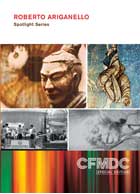
Spotlight Series: Roberto Ariganello 2007
Distributed by Canadian Filmmakers Distribution Centre, 401 Richmond St. W., Suite 119, Toronto, Ontario, Canada M5V 3A8; 416-588-0725
Produced by Roberto Ariganello
Directed by Roberto Ariganello
DVD, color, 75 min.
College - Adult
Film Studies, Media Studies, Fine Arts
Date Entered: 10/14/2009
Reviewed by Oksana Dykyj, Head, Visual Media Resources, Concordia University, MontrealRoberto Ariganello’s six finished films in existence have been compiled on DVD for CFMDC’s spotlight series on the artist. He died unexpectedly in 2006 at the age of 45 leaving less than an hour and half of work that was his own (2 films), or completed with two collaborators (4 films). He had spent the rest of his time generously helping others with conceptual or technical issues on their own films in his capacity as Executive Director at the Liaison of Independent Filmmakers of Toronto (LIFT).
What emanates from viewing these six films is his intense passion for films and the process of making them. This is an individual who began as a film enthusiast and then became a filmmaker. Two of the films are comprised of found footage and sound, two more are animations reminiscent of the animation work of Terry Gilliam, had he been possessed by the ghost of Joseph Cornell, and the last two being experimental documentaries that draw the viewer into worlds that are both banal and mysterious at the same time.
In Yesterday’s Wine (1999) Ariganello meshes the images from movies and serials from the 1930s and 40s with the sound of instructional language tapes to produce absurdist narratives. The notion of how stories are communicated comes into question and the film begs an examination of the thought processes involved in making meaning from the combination of image and sound. Shelter (2001) similarly addresses these issues but also throws in contemporary documentary footage from a demonstration during the Toronto Film Festival and a Pierre Berton television telecast, thus engaging in a discussion of the persistence and importance of the various types of media.
Contrafacta (2000) an animation film made in collaboration with Chris Gehman will delight medieval art historians with its cut-ups of iconic images and narrative detours, while Non-Zymase Pentathlon (1995) will engage dada and surrealist historians with its whimsy. Both Loteria (1996) and Gesture (1999) were done in collaboration with Federico Hidalgo and provide interesting approaches to the documentary. The formal filmic direction takes precedence over the subject matter, but it is not form over content but more aptly form revealing content.
CFMDC’s choice of highlighting Ariganello’s works is a good one. His work is accessible, enjoyable, and should be better known than it is. Recommended.